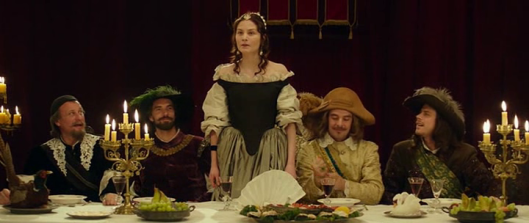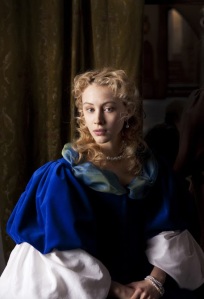Tags
17th Century Sweden, Christina of Sweden, Early Modern Europe, Ebba Sparre, Homosexuality, Interesting Women, Kings and Queens, Malin Buska, Sarah Gadon, Sweden, The Girl King
One of the standard clichés of royal biopics is the conflict between the monarch’s duties as sovereign and their desires as a private human being. Usually, the monarch yearns for their true love but then has to give that person up for the good of the kingdom. So we get this nice drama in which royal success is founded on royal misery. But occasionally we run into a monarch who goes off-script and chucks royal duty out the window.

Queen Christina of Sweden is one of the most unusual monarchs in history. Her father, Gustavus Adolphus, had made Sweden one of the great powers of Europe through his military leadership during the 30 Years War, but in 1632 he died on the battlefield when she was six, leaving her his heir. She was well-educated and proved to be a remarkably bright girl; by the time she was an adult, she had studied Greek, Latin, French, German, Dutch, Danish, Italian, Arabic, and Hebrew, as well as philosophy and theology. She took a keen interest in the emerging sciences of the Scientific Revolution, as well as art and history. She corresponded with various artists and scholars. She invited the legal scholar Hugo Grotius to become her librarian but he died before taking up the job. More importantly, she corresponded with the great French philosopher Rene Descartes and invited him to organize a scientific academy, although when they met they did not hit it off and he only saw her few times.
Her biggest challenge, however, is that like Elizabeth I of England, there was enormous pressure on her to marry, and she had a deep distaste for the idea. She disliked feminine things and became known for her unkempt hair. All her life she comported herself in decidedly unfeminine ways; she was a tomboy as a child, insisted on riding astride rather than side-saddle, and enjoyed fencing and bear hunting. She favored men’s shoes. Later in life, she took to wearing a justacorps (the fore-runner of the man’s frock-coat), a cravat, and a man’s wig. At the end of her life, however, she had returned to wearing women’s clothing, including gowns with a scandalously low neckline.

Scholars have struggled to understand Christina’s sense of her own identity. In addition to her mannish habits, her style of dress, and her rejection of marriage, there is some evidence that she was attracted to women. She wrote passionate letters to Ebba Sparre, her lady-in-waiting, but that was a common style of letter-writing at the time; she also once introduced Sparre to the English ambassador as her ‘bed-companion’. But she seems to have disliked most of her other ladies-in-waiting, considering them overly feminine. However, in her late 20s, she socialized so freely with men, including Cardinal Azzolino, that there was much gossip about it, and she wrote passionate letters to him as well. In 1541, one of her subjects accused her of being a ‘jezebel’, which got him executed.
There is no actual evidence that she ever had sex. So historians have variously classified her as heterosexual, bisexual, lesbian, asexual, and even intersex. (When she was born, she was so hairy that she was mistaken for a boy for several days.) It’s even been suggested that her refusal to follow social conventions might be evidence for Asperger’s Syndrome.
But Christina is most famous for her decision to abdicate her throne in 1654 when she was 28 years old and to abandon the Lutheranism she was raised in for Catholicism. Her interest in science seems to have led her to question Lutheranism, and long conversations with the Portuguese ambassador, a Jesuit, drew her to Catholicism.

Countess Ebba Sparre
Her decision to abdicate appears to have been the result of a complex set of issues. The constant pressure for her to marry and produce an heir was unpleasant for her. She slowly became more unpopular because of her decision to ennoble more than 300 families, all of whom had to be gifted with property to help them live a suitable lifestyle, and that property had to come from the Crown. Despite being a very hard-working monarch, she was accused of living a life of sport and indulgence. In 1651, she seems to have had a nervous breakdown from the stress of her office. And as queen she had to be a Lutheran. All of this fed into her decision early in 1654 to announce her abdication. She had already named her cousin Karl Gustav as her heir in 1649, so the transition was a relatively easy one.
She was granted a pension as well as revenue from a number of estates. She settled in Rome, although she undertook a number of visits to France, Naples, and Milan, as well as two visits to Sweden after the death of Karl Gustav. She contemplated trying to regain the throne, but was rebuffed because of her religion. She died in Rome in 1689 at the age of 62 and was buried in the grottos beneath St. Peter’s Basilica.
The Girl King
The Girl King (2015, dir. Mika Kaurismäki) follows Christina from her coronation to her abdication and does a reasonably good job of trying to condense the complexities of her story into a 90-minute film. Malin Buska’s Kristina is a strong-willing and highly intelligent woman whose free spirit is slowly choked by the demands of her situation. The film emphasizes her unconventional clothing, showing her frequently dressed in pants and men’s vests, although the historical Christina seems to have only adopted men’s clothing on a regular basis after her abdication. She fences, hunts, and regularly wears a sword.

Malin as Kristina addressing her subjects for the first time
The film is also interested in her intellectual interests. She acquires Grotius’ library after his death, plans to build a 500,000-volume library, and demonstrates her linguistic knowledge several times. The film claims that she became close friends with Descartes and that he helped lay the groundwork for her rejection of Lutheranism. As already noted, Christina and Descartes were not friends, and she didn’t agree with many of his teachings. But the film uses her friendship with Descartes as a short-hand for all the intellectual pursuits that undermined the faith of her childhood.
Any film about Christina has to decide what her sexuality was, and in this film she’s a lesbian. The moment she meets Ebba Sparre (Sarah Gadon), she is smitten by the woman, and as the film goes on she falls more in love with her. She declares Ebba her ‘bed-warmer’ and flirts with her increasingly. When Chancellor Oxenstierna (Michael Nyqvist) gives her several dresses as a way of trying to get her to marry his son Johan (Lucas Bryant), Kristina gives them to Ebba as an excuse to have her undress. Eventually, Ebba reciprocates her love, but just as they consummate their passion, Johan stumbles onto them. Jealous of Ebba, he kidnaps her and pressures her into marrying her long-time fiancé. The film suggests that Ebba’s choice to marry was such a deep betrayal of Kristina that it set in motion the queen’s choice to abdicate. This is going far beyond what the historical evidence will support, but it presents a coherent narrative out of the rather confused and indeterminate evidence of Christina’s complex motives.

Gadon as Ebba
The film certainly oversimplifies. Although it acknowledges a decade passing by, it still manages to compress the events of Christina’s reign into what seems like 18 months; no one in the film ages perceptibly.
And despite its deviations from fact, the film does an impressive job with a lot of little details. For example, the dress that Kristina gives Ebba is identical to one in an actual portrait of Ebba Sparre (compare the two images of Sparre above). Kristina seduces Ebba by showing her the Codex Gigas, the so-called ‘Devil’s Book’, supposedly written by a medieval monk in one night, with the aid of the Devil. The film references Descartes’ interest in the pineal gland and correctly shows foreign ambassadors encouraging Christina’s interest in philosophy as a way to seduce her from Lutheranism (although in this film, it’s the French ambassador, not the Portuguese one). So although the film gets a lot of things wrong, it makes an effort to include a lot of small details that are true.
The film also does a nice job with Christina’s sexuality. Its portrait of a young lesbian fumbling her way toward her first love at a time when lesbianism was taboo is sensitive, not sensational. It presents her desires as natural but still acknowledges that her society cannot accept them, while avoiding exploitation of the subject matter. So if you only see one movie about a lesbian, cross-dressing queen, make it this one.
Want to Know More?
The Girl King is available on Amazon.
There don’t seem to be any scholarly works on Christina that are both scholarly and accessible to the general reader. Veronica Buckley’s Christina Queen of Sweden is probably your best bet. Buckley isn’t a scholar, but she’s been praised for a very readable style.



Miss Gadon seems to be making a career out of playing the object of affection of unusual European monarchs.
LikeLike
There’s something to be said for finding your niche.
LikeLike
Can I safely say this was far better than DRACULA UNTOLD?
LikeLike
Oh hell yes. Not a damsel around to euthanize.
LikeLike
And speaking of dressing her, a delicious Persian coat of hers survives and is in the armory. http://www.islamicpersia.org/2012/12/safavid-jacket-in-stockholm.html?m=1
LikeLiked by 1 person
Gorgeous!
LikeLike
That is truly fascinating.
LikeLike
One thing I like about this blog is that it gives me a chance to dig into subjects way outside my area of focus. I often wind up learning things
LikeLike
“One thing I like about this blog is that it gives me a chance to dig into subjects way outside my area of focus. I often wind up learning things”
IMO, this is the true value of your blog Andrew! Yes I have the enjoyment of your insights into movies I have seen, but it’s really the often tangential information in your writing that sets me off on discovery missions! Thank you so much and keep it it!!
LikeLiked by 1 person
Thank you so much! I’m glad you learn from it.
LikeLike
I apologize for pointing this out, but you refer to her at the beginning as “Queen Christina of Denmark,” when you meant to say Sweden. I think you should fix it.
BTW, one of the families Queen Christina ennobled was the Gyllenhaals, now of Hollywood fame.
LikeLike
Whoops! Thanks for catching that! I’ll fix it.
LikeLike
How does the Garbo film stand up? Is it accurate at all, or is it the usual Golden Age romanticism over reality?
LikeLike
I confess I haven’t seen the Garbo film.
LikeLike
Neither have I. I’m sure I’ll get around to it one of these decades.
LikeLike
Glad you liked it. I did too. Even if I couldn´t bond to her in a human level (she´s not very lovable) I did empathized with her rebellness and toyally admired her love for culture. Even if from the cover on everything seems to be centered in “she´s a lesbian”, when you actually see the movie is not about that (a plague on your houses, marketing people!!). It´s about this lady, who was a lot of things, a lesbian among them, and primarely loved culture. I think that´s the most important feature for the screeenplay writer/director. Or at least that´s what I got out of it.
LikeLike